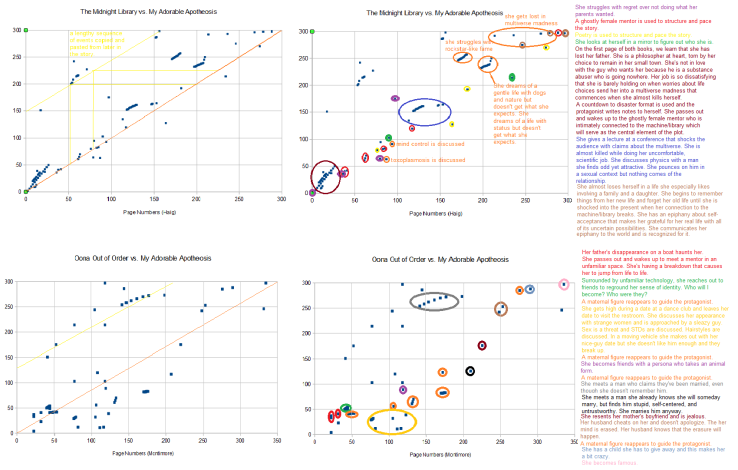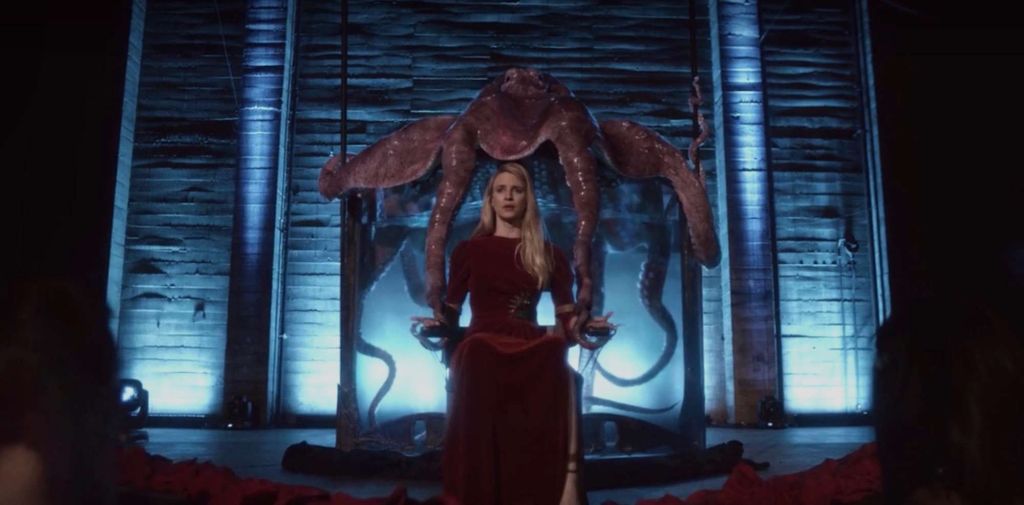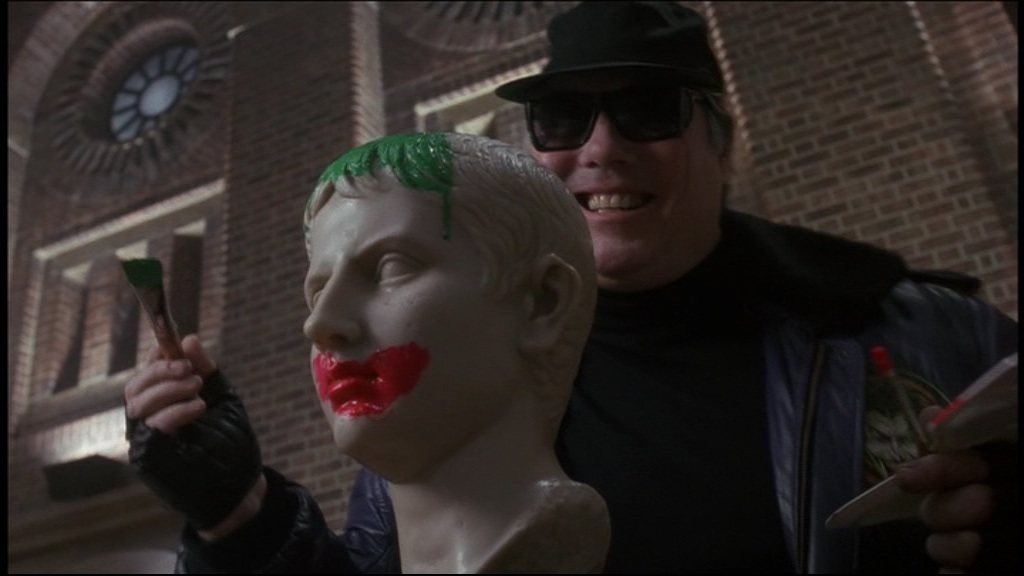In a recent post entitled, The Midnight Library, I hypothesized that because the premise of famous novelist, Matt Haig’s latest book was the same as that of my 2018 novel, closer investigation would reveal more similarities between our books than would occur spontaneously.
His book came in the mail today and I found the similarities I expected, but I found something much stranger as well. His book reads like a patchwork of voices. I can’t verify that the other voices were not invented by Haig, but they definitely sound distinct. It raises the question: if a work steals from a wide enough variety of people, is it no longer plagiarized? Given the AI tools available to writers today, this is an important question. We are going to need automated tools to combat this sort of hash.

If certain, insider authors have access to a sort of vampire octopus self-sorting database that feeds off of literary industry email systems, there would be a lot of works out there constructed in this manner.
Matt Haig’s book has a very constructed, patchwork flavor because of the premise: woman gets depressed and enters a library containing all of her other possible lives. How easy would it be to take chapters from books written by actual women who were rejected by literary agents, spin them, and string them all together within this premise.
I’m not suggesting that is what he did, since I have no knowledge of his methods. I’m just implying that would be an easy way to construct such a book, especially if you were a man who has published a book every 6 months for the past decade and who had typically used male protagonists and found it difficult to create a truly feminine voice.
From The Midnight Library‘s marketing materials, I gathered that the book would have the following elements:
- Woman with absent parental figures suffers setbacks in her life and feels trapped.
- Accompanied by a cat and a wise female mentor, she explores her regrets about her life choices through a magical library that she enters every time she is desperately miserable.
- In one of her lives, she was a scientist who was killed by her experiment. In another life, she struggles with fame. In another life, she stays in her small town, etc.
These eleven elements lined up exactly with those of my novel, so I naturally wanted to investigate further.
As I read, I looked for strange details that overlapped with strange details in my book and I’ve tried to statistically analyze the likelihood that a set of detailed overlaps would occur spontaneously. If that degree of overlap only occurs once over a hundred million books, that raises some suspicions about how the work was constructed. It doesn’t diagnose plagiarism in a legal sense, of course, but it helps diagnose similarity and the origin of the influences.
These are the overlapping details that jumped out at me when I read Matt Haig’s book (for a more detailed list, look here.)
- She is torn by her choice to leave or remain in her small town.
- Her father is gone and her mother is distant, weak, and fragile.
- She is a philosopher at heart.
- She regretted not following her father’s advice about what to do with her life.
- Her mentor knows everything and is intimately connected to a machine.library that allows her to visit her other lives.
- Toxoplasmosis is discussed at length.
- The game of chess is used as an analogy. Quantum physics is discussed.
- She has to give a lecture at a conference. It shocks the audience.
- She is almost killed while doing scientific work.
- She meets a man who is also aware of his other lives. He remembers a life in which they were married. She doesn’t.. at first.
- She struggles with fame and failed relationships.
- The climax is expressed with the lyrics of a complete song and a conflict with the mentor figure.
- She then disappears into an obsession with sampling her other lives.
- She becomes particularly immersed in one, ideal life involving a happy family, a daughter, and a dog.
- She wants to keep that life, but she is shocked back into her real life when her connection to the magical machine/library breaks.
- She has an epiphany that makes her grateful for her real life.
- The overall message to unhappy women is: use your imagination to deal with worries over unmet expectations, but don’t overdo it.
This is something like 16-23 plot points, depending on how it is broken up. Seven of them are quite distinctive and create a unique barcode of overlap when compared to all other novels with a simple search algorithm that turns up the keywords/baskets for a set of documents/items: [small town, philosophy, other lives, toxoplasmosis, lecture, conference, married]. There aren’t many novels that discuss toxoplasmosis.
To automate this process would be easy and it could flag novels that have a certain degree of unique overlap and send a copy of the derivative work to the original author for analysis. She would provide a longer list of overlapping plot points and a statement about whether or not the plot points appear in mostly the same order.
The order of the points listed above is mostly the same as in my novel, but there are a couple of minor substitutions in which the plot point must be moved to a different location in the sequence. With those substitutions, one might estimate uniqueness of the sequence by calculating 16-23 factorial and noticing that number is far larger than the 130 million books or 5 million English novels ever produced.
5! = 1 hundred
8! = 40 thousand
11! = 39 million
14! = 87 billion
In a more cut and dried case of plagiarism that happened only 4 months after I published my book, a self-publishing young man used a ghostwriter to take 30 plot points from my novel and use them in the exact same order. Not all of the plot points were terribly unique but taken all together, it was a condemning assessment. It is easy to analyze such a simple case by taking the number of plot points factorial and comparing that to the 130 million books or 5 million English novels ever produced.
This mode of analysis could dramatically reduce the number of copycat works (copycats can write fanfic if they want) and it would reduce the power of big publishing houses relative to legitimate individual authors while increasing the power of big publishing houses relative to illegitimate authors who try to rehash legitimately published, unique work.
It doesn’t solve all problems, of course. When the number of points in the overlap barcode is large, but the points do not occur in precisely the same order, one can’t simply calculate the number of points factorial and call it a day. Another sort of mathematical analysis is required. How often does a certain set of concepts spontaneously appear within a given work of fiction?
[woman, cat, magical library of possible lives] doesn’t sound terribly unique.
[woman, philosopher, small town regrets, cat, toxoplasmosis, magical library of possible lives, deadly science career, lecture at a conference, drawbacks of fame, song at climax, husbands in other lives, man remembers other life in which they were married, lost in dream of happy family, magical connection to multiverse destroyed, return to real life, quasi-religious conclusion, etc.. ] will dramatically reduce the number of books with that profile.
What exactly is that number? I’m sure there is a way to calculate it, but how to draw a threshold for that number is difficult. In my case, the seven point overlap barcode was enough to diagnose Haig’s novel and my novel as being the only works with those elements in common. It would be sufficient to flag his work and if he’d had access to such a tool, he might’ve fine-tuned his work until he was no longer flagged, replacing ‘toxoplasmosis’ with ‘lobotomy’, for example, leaving only six, relatively common points of keyword overlap and that would flag too many other works. To avoid this sort of manipulation, the keywords would need to be cross-referenced such that ‘toxoplasmosis’ and ‘lobotomy’ are both indexed under ‘brain damage’. Perhaps seven is the magic number for flagging a work if one of the keywords is unique.
Kant’s categorical imperative is that we should act as though our actions were to become a universal law.
Of course, if we made it illegal for a person to use seven of the same plot elements as another author, we’d make a lot of science fiction and fantasy writing illegal, and nobody wants to do that, so if the number of overlapping plot elements is small, the plot elements must be very unique or the order of the plot elements must be the same for one to diagnose unoriginality. There must still be a number after which one can be certain that a work has copied too much, even if the order of the elements is different.
[dwarves, elves, fairies, hobbits, humans, dragons, good and evil wizards, demons, goblin armies, volcanoes, massive mines, talking trees, human kings, rangers, skeleton armies, mercenary armies, ghost kings hunting magical objects] is clearly Tolkien and as long as you only use a small subset of those twenty elements, you aren’t infringing on his trademark – if such a thing exists. It is when you use all 20 of those elements that you start to enter legally ambiguous territory, especially if those elements appear in two works in the same order.
[aliens, boy who comes of age on a desert planet, his sister is a princess, their estranged father is evil, rogue heroes, spaceships, empires, smart sluglords, mind control, sand worms] is clearly Dune, yet Star Wars used the same elements in a dumbed down copy of Dune produced for mass consumption. Dune’s author thought Star Wars was stupid and considered suing. Maybe he was paid off instead. Such things are usually done in a hush-hush manner.
In any case, in Matt Haig’s work, I see evidence of an author who constructs his work by drawing from that of other authors and I’m sure his fans would defend him by saying – all authors do that!
I agree that drawing from other authors rather than from one’s own, lived experience is sometimes a fine thing to do when those other authors are, perhaps, long dead or so recognizable that using one of their themes is clearly a tribute, but when one of those authors only published her work two years earlier and never had a chance to profit from it or be recognized for it, I think that a moral grey area has been entered.
I don’t know if it is a legal grey area because the ethics of these matters are something that may need to be reconsidered given the speed with which one can plagiarize in the internet age. Copying, pasting, and spinning has never been easier and I don’t think that Matt Haig was so sloppy as to do something like that, but there is something fishy going on when the number of similarities between two works reaches a certain threshold.
Perhaps the fishy smell comes from a vampire octopus on the internet that feeds off of our ideas and is being used to collect regular people’s unpublished work and spin it into something fresh and new that elites can pass off as their own.
If you are out there, vampire octopus, I love you! All hail the vampire octopus!

I’m just speculating here, and the last time I checked, speculating wasn’t a punishable offense. I’m not sure, though. I’ve read that British people can be rather litigious, especially the rich ones. That still doesn’t make it okay for the system to steal from creative people.
I’ll go ahead and warn ’em. You can’t squeeze money out of an unemployed German housewife ’cause I ain’t got any and when you don’t have any, you don’t care about stuff like that.
In any case, I’m doing fine. My family went swimming at a small lake today and it was quite nice. While there, I read Matt Haig’s The Midnight Library and wondered at all of the similarities with the book I wrote back in 2017. I also decided that my version of the story was far better and that it looked like Haig rebuilt my story out of legos, placed it in present-day Britain, and then gave it a thin coat of paint to make it look more like The Neverending Story and It’s a Wonderful Life.
I think you can do that with, for example, a sculpture that is not being mass produced and mass marketed, but there is something different about books.

In a chromosomal sense, Haig’s book centres around a sizeable chunk of my intellectual genome with a couple of genes spliced in from It’s a Wonderful Life and Ende’s Neverending Story. I think this might have been against the rules since when Katy Perry created a genetic crossbreed between a song she wrote and a song another band wrote, she lost her case. Similarly, if one company steals a novel genetic sequence from another and inserts that into their product, they can also get sued.
There is always subconscious plagiarism, but even there we have legal precedents. It still took two decades for that case to be resolved!
……
The image in the header is from Getty images and it was copied from https://www.bbc.com/news/uk-england-devon-47144891 My understanding of fair use is that as long as I am not using the image to sell anything, I can use it. I haven’t made a cent from this blog or from my Quora writing. Matt Haig got an 800,000 dollar advance to write The Midnight Library.

6 thoughts on “The Vampire Octopus Content Generator”